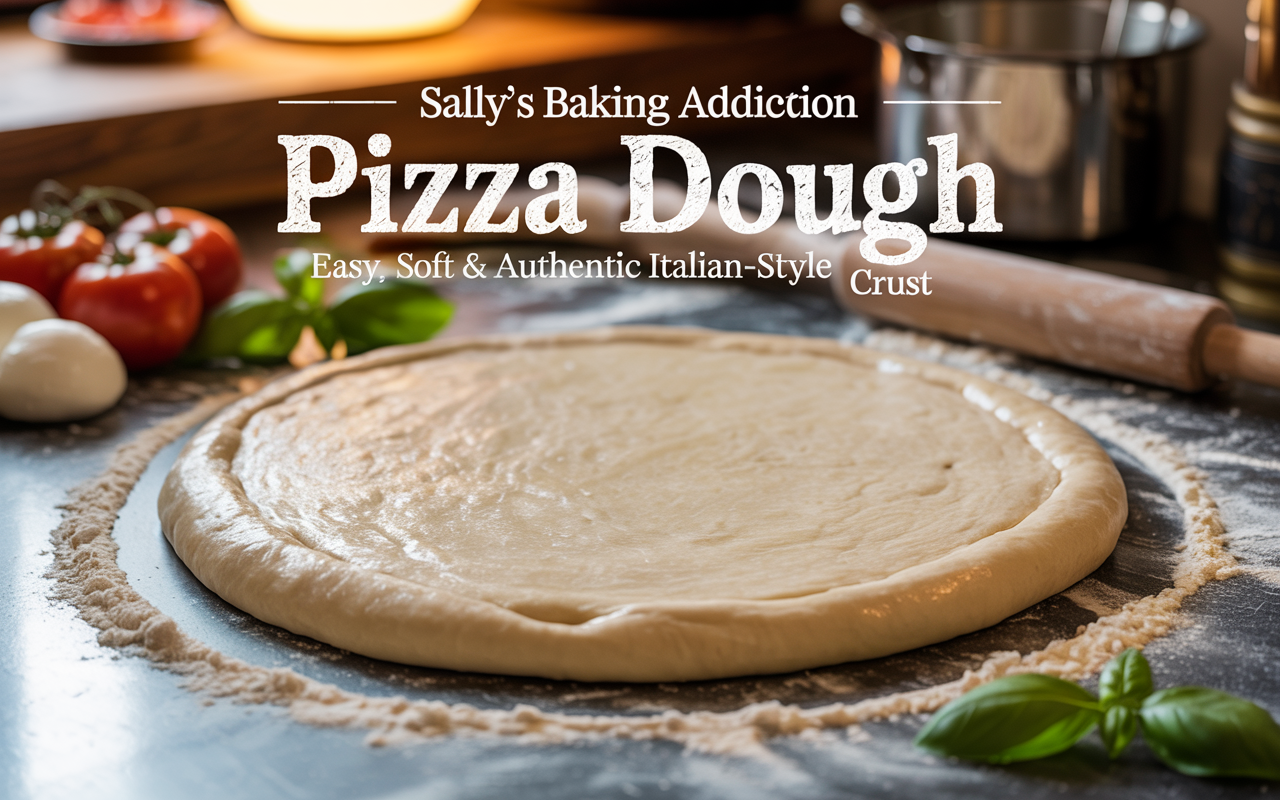The Ultimate Sour Dough Pizza Dough Recipe – Crispy, Chewy, and Packed with Flavor
There’s pizza dough… and then there’s sour dough pizza dough. Once you’ve tasted that deep, tangy flavor paired with a crisp crust and chewy center, there’s no going back. It’s the kind of pizza base that feels rustic, authentic, and full of character—like the kind you’d find in an old Italian trattoria where recipes have been passed down for generations.
I’ve spent years tinkering with dough recipes. Some quick and easy for weeknights, others slow and patient for weekends when I really want to lean into the art of baking. But let me tell you—nothing compares to the satisfaction of pulling a bubbly, charred sourdough pizza from the oven. It’s the perfect marriage of Old World tradition and modern home cooking.
If you’ve been nurturing a sourdough starter and wondering how to put it to delicious use, this sour dough pizza dough recipe is the answer. And if you’re new to sourdough? Don’t worry—I’ll guide you through every step so you feel confident from mixing to baking.
Let’s dive in.

Ingredients for the Sour Dough Pizza Dough
The beauty of sourdough is its simplicity. A handful of ingredients transforms into something magical thanks to time, patience, and natural fermentation.
| Ingredient | Measurement | Notes |
|---|---|---|
| Active sourdough starter (fed & bubbly) | 150 g (about ¾ cup) | Make sure it’s active before using |
| All-purpose flour | 400 g (3 ¼ cups) | Or use bread flour for extra chew |
| Whole wheat flour | 100 g (¾ cup) | Optional, adds nuttiness & depth |
| Water (room temperature) | 325 g (1 ⅓ cups) | Filtered if possible |
| Olive oil | 1 tbsp | Enhances flavor & texture |
| Salt | 10 g (1 ¾ tsp) | Don’t skimp—salt balances the tang |
This makes enough dough for two medium pizzas or one large sheet-pan pizza.

Step-by-Step Instructions
Step 1 – Feed your starter
Before you do anything, make sure your sourdough starter is lively. Feed it 6–8 hours before you plan to mix your dough, and use it when it’s bubbly, airy, and passes the “float test” (a spoonful should float in water).
Step 2 – Mix the dough
In a large bowl, combine water and starter. Stir to dissolve. Add the flours and mix until no dry bits remain. The dough will look rough and shaggy—that’s fine. Cover and let it rest (this is called autolyse) for 30 minutes.
Step 3 – Add salt and oil
Sprinkle the salt and drizzle in the olive oil. Work them into the dough by pinching and folding. Don’t worry if it feels sticky—it’ll smooth out as gluten develops.
Step 4 – Stretch and fold
Instead of kneading, you’ll do a series of gentle stretch-and-folds over 2–3 hours. Every 30 minutes, grab one side of the dough, stretch it up, and fold it over itself. Rotate the bowl and repeat 3–4 times. This strengthens the gluten while keeping the dough airy.
Step 5 – Bulk fermentation
After the stretch-and-folds, cover the bowl and let the dough rest at room temperature until it’s puffy and has nearly doubled in size. Depending on your starter strength and room temperature, this could take 4–6 hours.
Step 6 – Cold ferment
For maximum flavor, refrigerate the dough overnight (up to 72 hours). This slow fermentation develops that deep sourdough tang and makes the dough easier to handle.
Step 7 – Shape
When you’re ready to bake, remove the dough from the fridge and let it come to room temperature for 1–2 hours. Divide it into portions, shape into rounds, and let rest for 30 minutes under a towel. Then gently stretch into pizzas by pressing from the center outward—avoid using a rolling pin to preserve the air bubbles.
Step 8 – Bake
Preheat your oven to its highest setting (usually 475–500°F / 250°C). Place your shaped dough on a pizza stone or baking sheet. Add sauce, cheese, and toppings. Bake for 8–12 minutes until the crust is blistered and golden.

Why This Recipe Works
- Natural fermentation: Gives you complex flavor you’ll never get from commercial yeast.
- Stretch-and-fold method: Builds gluten without overworking the dough.
- Cold ferment: The longer the rest, the better the taste.
- Simple ingredients: Nothing fancy—just flour, water, starter, salt, and oil.
Tips & Tricks for Perfect Sourdough Pizza
- Use strong flour. Bread flour gives more chew, all-purpose makes it softer. A mix works great.
- Be patient. Sourdough is slower than yeast dough—but that’s where the magic happens.
- Don’t overload toppings. Let the crust shine. A light hand gives you balance.
- Bake on steel or stone. It mimics the heat of a wood-fired oven.
- Brush edges with olive oil. For that irresistible golden glow.
- Adjust hydration. Wetter dough = more open crumb. Drier dough = easier to handle.
- Keep it rustic. Uneven edges and bubbles? That’s the charm of sourdough pizza.
FAQ Section
Q: Can I use discard for this recipe?
Not recommended. You need an active starter to get the rise and flavor.
Q: What if my dough is too sticky?
Wet dough is normal with sourdough. Flour your hands and work surface lightly, but don’t add too much extra flour or you’ll lose the airy texture.
Q: How long should I cold ferment the dough?
Anywhere from 12 hours to 3 days. Longer = more flavor.
Q: Can I freeze sourdough pizza dough?
Yes. Freeze after the bulk fermentation stage. Thaw in the fridge overnight, then shape and bake.
Q: Do I really need a pizza stone?
Not essential, but it makes a big difference. A cast-iron skillet also works beautifully.
Final Thoughts
There’s something soulful about sourdough pizza. It’s not just about feeding yourself—it’s about embracing time, tradition, and patience. Every step, from feeding your starter to pulling that blistered crust out of the oven, connects you to centuries of Italian bakers who relied on natural fermentation long before yeast came in a packet.
This sour dough pizza dough recipe is simple enough for beginners yet rewarding enough for seasoned bakers. It’s a dough that tells a story—one of flavor, heritage, and the joy of homemade food.
Next time you’re craving pizza night, skip the takeout. Nurture your starter, trust the process, and let sourdough transform your crust into something extraordinary. Once you taste it, you’ll understand why I keep coming back to this recipe again and again.
Buon appetito, and happy baking! 🍕✨
See Also: Simple Pizza Crust Recipe – Easy, Homemade & Perfect Every Time







